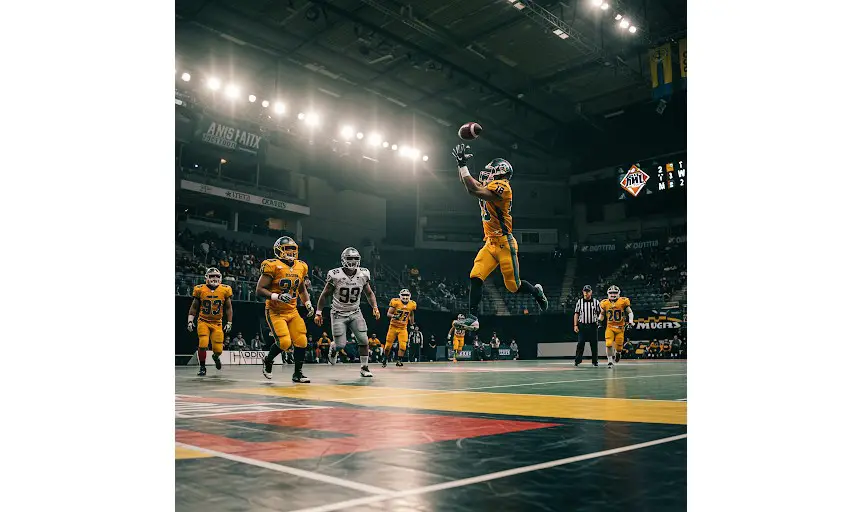
The Fast-Paced World of Arena Football: History, Rules, and Global Impact
Arena Football is a dynamic, high-octane variation of traditional American football. The sport combines speed, power, and spectacle. Unlike its outdoor counterpart, Arena Football is played indoors on a smaller field, creating a faster-paced experience. This version of football appeals to fans who crave non-stop action and high scoring games. Since its inception, Arena Football has carved a unique place in the sports world. Its evolution has sparked interest across continents, inspiring both professional and amateur leagues.
The Origin and History of Arena Football
The concept of Arena Football originated in the early 1980s. Jim Foster, a former executive with the NFL and USFL, envisioned a new kind of football. While attending an indoor soccer match at Madison Square Garden, he imagined football being played indoors. Foster sketched the initial field design on a manila envelope. He then developed a unique set of rules to fit the indoor setting.
In 1987, the Arena Football League (AFL) was officially launched. The first game took place on June 19, 1987, between the Pittsburgh Gladiators and the Washington Commandos. Held at the Civic Arena in Pittsburgh, this game introduced fans to a thrilling, fast-paced sport. Over the next decade, the AFL gained popularity, with new teams joining and television deals being secured.
During the 1990s and early 2000s, Arena Football experienced rapid growth. Major television networks like ESPN began broadcasting games. NFL players and coaches took interest in the league. Some even transitioned between the NFL and AFL. Despite financial challenges in the late 2000s, the AFL continued to influence other leagues.
In 2009, the original AFL filed for bankruptcy, pausing league operations. However, the league was later revived and continued play. Several spin-off leagues and international variants emerged, demonstrating the sport’s resilience and appeal.
Global Popularity and Geographic Reach
Arena Football is primarily associated with the United States. However, its influence has extended beyond North America. Countries like Mexico, China, and Brazil have embraced the sport. International leagues have adapted the rules to local tastes and logistical realities.
In Mexico, the Liga de Futbol Americano Profesional (LFA) has incorporated indoor-style games. The country’s passion for American football made Arena Football a natural fit. China introduced the China Arena Football League (CAFL) in 2016. This league featured players from both China and the United States. Games were held in major Chinese cities, gaining a loyal fan base.
Brazil has also experimented with Arena Football. Local clubs and amateur leagues have sprouted in São Paulo and Rio de Janeiro. Social media and online streaming have furthered global exposure. Fans from Europe and Australia follow American and international leagues online.
While the sport has not reached the mainstream status of soccer or basketball, it continues to grow. Enthusiasts around the world appreciate its intensity and entertainment value.
Amateur Arena Football: Youth and School-Level Participation
Youth and amateur participation plays a crucial role in the sport’s development. Across the United States, many schools and community programs offer Arena Football for children and teens. Modified rules ensure safety while maintaining the sport’s high-energy appeal.
High school leagues in states like Texas, Florida, and California have introduced Arena Football. These leagues operate during the traditional football offseason. They provide additional opportunities for young athletes to compete and improve.
Youth leagues often use smaller arenas or gymnasiums. Coaches focus on fundamentals like quick decision-making and precision passing. This environment nurtures future talent while keeping young players engaged.
Colleges and universities have also explored the sport. While not part of the NCAA structure, club teams and intramural leagues bring Arena Football to campuses. These programs attract students who may not play varsity football but still love the game.
Internationally, youth Arena Football remains less organized. However, grassroots efforts in countries like Mexico and China have begun to yield results. Training camps, youth tournaments, and exchange programs foster international development.
Professional Leagues Around the World
The original Arena Football League remains the sport’s most iconic professional organization. Although it has faced setbacks, it paved the way for others. Several notable leagues have followed in its footsteps.
The Indoor Football League (IFL) was established in 2008. It absorbed teams from previous leagues and created a competitive, sustainable structure. The IFL currently hosts teams across the United States. It features a mix of veteran players and rising stars.
Champions Indoor Football (CIF) also plays a significant role. Founded in 2014, CIF offers an accessible platform for smaller markets. Games are intense, and communities rally around their local teams.
Internationally, the China Arena Football League broke new ground. Launched with American support, the CAFL aimed to create a global football brand. Although its operations have been intermittent, it left a lasting mark.
Mexico’s LFA occasionally incorporates indoor elements. Teams experiment with Arena-style games during special events. These matches generate excitement and broaden the sport’s fan base.
European leagues remain mostly outdoor-focused. However, clubs in Germany and Poland have hosted indoor tournaments. These events introduce new fans to the sport’s unique features.
Rules of Arena Football
Arena Football differs from traditional American football in several key ways. The field is smaller—typically 50 yards long and 28 yards wide. Walls surround the field, adding physicality and strategy.
Each team has eight players on the field, unlike the traditional eleven. Offenses focus heavily on passing. The condensed field encourages quick plays and high scoring.
Games consist of four 15-minute quarters. The clock stops less frequently than in the NFL, keeping games fast-paced. Teams have three timeouts per half.
Kickoffs and punts are handled differently. The ball must hit the rebound nets to remain in play. These nets introduce unpredictable bounces, adding excitement.
One offensive player may be in forward motion before the snap. This rule benefits receivers and speeds up play. Defenses must adapt quickly.
Penalties and scoring follow general football standards. Touchdowns are worth six points, with one-point or two-point conversion attempts afterward. Field goals are worth three points.
The game emphasizes entertainment. Music, announcers, and fan interactions are integral to the experience. Teams often include dance squads and themed promotions.
Political and Social Significance
Arena Football carries social and political implications. In the United States, it has provided opportunities for athletes outside the NFL. Players from underserved communities often find a platform in Arena leagues.
The sport also creates jobs and boosts local economies. Teams hire coaches, trainers, marketing staff, and game-day personnel. Small and mid-sized cities benefit from hosting franchises.
Socially, the sport promotes inclusivity. Community outreach programs often accompany Arena Football teams. Clinics, charity events, and school visits strengthen local ties.
Arena Football also challenges traditional gender roles. Some leagues have included female coaches and staff. Discussions about expanding participation for women continue to evolve.
Internationally, the sport has served as a bridge between cultures. The CAFL, for example, brought American and Chinese players together. These partnerships fostered mutual understanding and respect.
Politically, the sport remains less controversial than major leagues. However, it reflects broader trends in sports diplomacy and international cooperation. Cultural exchange through sports often softens geopolitical tensions.
Conclusion
Arena Football stands as a vibrant, evolving sport with global potential. Its unique rules, fast pace, and inclusive nature set it apart. The sport’s history reflects resilience and innovation. From American high schools to Chinese arenas, Arena Football continues to captivate.
Professional and amateur leagues alike contribute to its steady growth. As digital media expands access, more fans around the world will discover its thrills. Politically and socially, the sport serves as a unifying force. It brings communities together and opens doors for athletes.
In every touchdown and tackle, Arena Football offers more than entertainment. It represents opportunity, connection, and the future of a global game.





